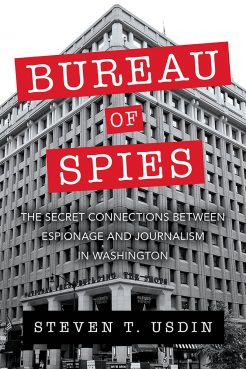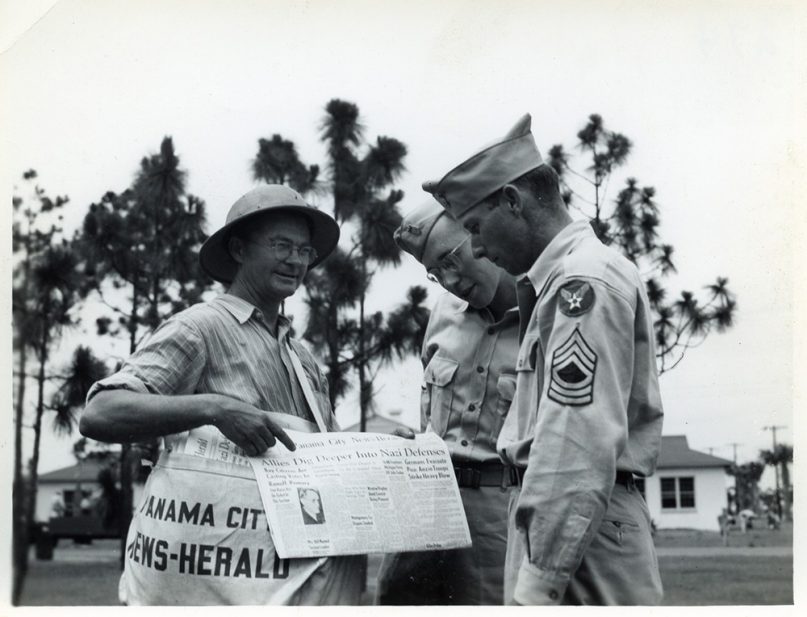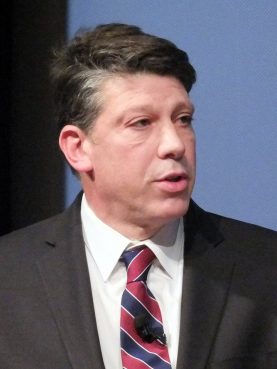
(RNS) — When the Jewish Telegraphic Agency launched the Overseas News Agency in 1940, JTA’s new subsidiary promised to report the facts and to “indulge in no propaganda, preach no theory or philosophy.”
But before ONA was a year old, according to a new book, it had partnered with Britain’s foreign intelligence agency to spread fake news aimed at discrediting Hitler and enlisting the United States’ help with the war in Europe.
The news wire also reportedly tried in vain to work with the FBI and may have collaborated with the predecessor to the Russian spy agency, the KGB.

Image courtesy of Prometheus Books
From the start, said Steven Usdin, author of “Bureau of Spies: The Secret Connections Between Espionage and Journalism in Washington,” ONA made attacking Nazi Germany a priority over reporting the truth, aligning itself with the interests of British Security Coordination, the New York outpost of MI6, the British equivalent of the CIA.
ONA’s anti-Nazi propaganda work raises the question of whether fake news can ever be a good thing, said Usdin, who is the Washington, D.C., editor of BioCentury, which tracks life sciences policy and biotechnology.
“There are times where people say that it’s appropriate or OK to compromise with some kind of ethical principle because there’s an existential threat, but it’s usually not true,” he told Religion News Service. “Here, it really was. I would have done it, and I would have been proud of it.
“I think it’s extraordinary,” Usdin said. In declassified documents, MI6 doesn’t talk about just having influence over the wire service. “They basically say that they have effective control over ONA,” he said.
British intelligence used that control to plant lies that are the stuff of The Onion.
“Hitler’s paranoia has reached the point where he suffers from delusions,” read one “sib,” the British spies’ shorthand for the Latin sibilare, a whisper or hiss. “He has an uncontrollable fear that his mustache is growing more and more like Stalin’s, and he has it shaved every morning much closer than usual.”
The mustache rumor never made it into print, as far as Usdin has found, but mainstream media reported equally outlandish sibs, including an ONA tale that 200 man-eating, Australian sharks had been imported to the English Channel to dissuade German sailors and pilots from attempting to cross.
“That seems like something that someone thought of over a pint,” Usdin said. “They just threw a lot of mud, and whatever stuck on the wall, they were happy with,” Usdin said. “I think they also thought Americans were particularly gullible.”
On Nov. 2, 1941, The New York Times ran a front-page Associated Press story, based on ONA reporting, claiming that the British navy was using a superexplosive, 47 times as powerful as TNT.
The report read “as if the British government was in the habit of revealing military secrets to any reporter clever enough to ask the right questions,” Usdin writes.
The following day, the Times buried a small story stating that “more imaginative rumors” of highly secret British ammunition “should be taken with perhaps a little more than the proverbial grain of salt.”
Another planted story that ran in the Times held that a 130-year-old Bedouin soothsayer’s death was being taken in the Middle East as a sign of Hitler’s imminent downfall.

A.C. Corley, left, sells copies of the Panama City News-Herald with the headline “Allies Dig Deeper Into Nazi Defenses” to Moody Busby and Roger Keough circa 1942. The photo was used in the June 3, 1944, edition of the Tyndall Target. Photo courtesy of Tyndall Target/Creative Commons
Founded by Jacob Landau as the Jewish Correspondence Bureau in The Hague in 1917, the news agency moved four years later to New York. When the war broke out in Europe, according to a 1984 JTA story, The New York Times and other subscribers felt they couldn’t continue to use the JTA name, saying it was “too ‘parochial’ and implied biased news reporting.”
But within a year of ONA’s founding in 1941, 50 American and Canadian dailies carried its stories, the JTA added.
JTA’s website doesn’t detail any collaboration with spies, and Usdin said there’s no evidence its reporters knew of ONA’s deal with the British. MI6 declined to comment, instead referring RNS to official history of the war period the agency released a few years ago.
But, according to Usdin, the deal went as follows: British intelligence agreed to fund the JTA subsidiary in exchange for ONA press credentials for its spies and the right to use the outlet to spread fake stories in the U.S. and international press. Besides The New York Times, the New York Herald Tribune, San Francisco Chronicle, The Philadelphia Inquirer, The Washington Post and others ran its stories.
The Austrian-born founder, Landau, tried to pitch the FBI on a similar deal, but his accent got in the way. In an April 1942 memo, assistant director Percy E. Foxworth wrote to his boss, J. Edgar Hoover, of a meeting with Landau where he suggested that JTA and ONA, with their network of 600,000 South American Jews and foreign-language newspaper clients, could assist the bureau.
“Since Mr. Landau’s English was very poor, and it was rather difficult to understand his exact proposition, I requested that he prepare a memorandum outlining in detail just what he felt his group would be able to do and the estimated expense involved,” Foxworth wrote.
In the memo, Landau suggested, among other things, that ONA could employ noncitizens with extensive information. “Your employing them directly has obvious disadvantages,” he wrote.

Steve Usdin. Photo courtesy of @steveusdin1
Usdin never found definitive proof that Hoover declined to hire Landau, but two years later an FBI memo noted that it had investigated Landau, JTA and ONA for failing to register as foreign agents. Usdin noted that about this time Hoover had turned on the British after BSC began collaborating with the Office of Strategic Services, the predecessor to the CIA, and went after several BSC operatives.
Several Soviet secret cables also mention ONA, and a third seems to discuss granting credentials or a visa for an ONA reporter to work in Moscow. Yet another document reveals that the Soviets knew Landau was working with an intelligence agency.
After writing a 2005 book about the Julius and Ethel Rosenberg spy ring, Usdin began working on a guide to Washington espionage sites, and he was working on a sidebar on the National Press Club when he realized that stories about spying at the club, where ONA had its D.C. office, could fill a whole volume on its own.
His office filled with stacks of Freedom of Information Act files, but he began to question how wide an appeal the book could have.
“Every day, I would look at the stack, and it would look back at me,” he said. “Every once in a while, I would pretend I was working on a book.”
Then, all of a sudden, fake news and attempts to influence elections were dominating the national conversation, and his research got a new life.
In the book, Usdin notes that the overwhelming majority of journalists in the war years neither worked for nor collaborated with intelligence officials and didn’t plant fake stories.
When critics say he shouldn’t have written this book during the Trump era, he pushes back. “It’s tremendously irritating to me that an area of inquiry should be off-limits, because people can misinterpret it,” he said. “That’s not history. That’s something else.”
He also advises approaching the news with humility that comes from poring over lessons of the past. Isolationists during World War II have come down on the wrong side of history, he said, but noted they were dismissed at the time as right-wing fearmongers for their charges that British intelligence was operating in the U.S. and placing fake stories in U.S. newspapers.
“It turned out they were right,” Usdin said.
